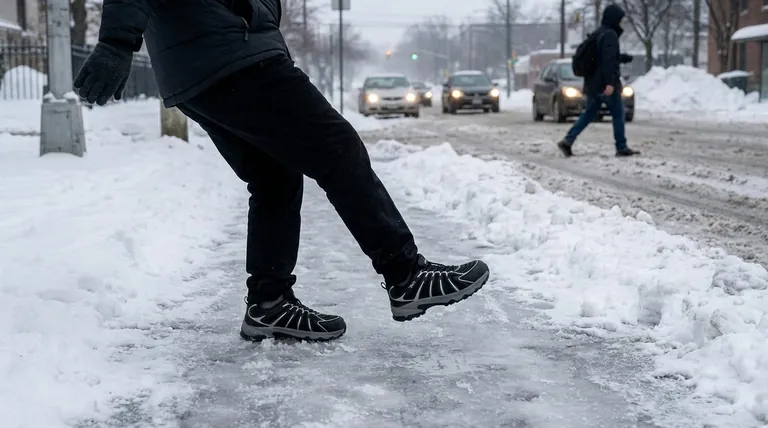In short, icy and snowy conditions pose a significant risk of slips, trips, and falls for pedestrians. These incidents can lead to a wide range of injuries, from minor bruises to severe fractures and head trauma. Blocked sidewalks can also force people to walk in the street, exposing them to traffic-related dangers.
The fundamental problem isn't just the visible ice or snow, but how these conditions fundamentally alter a pedestrian's relationship with their environment, introducing instability and forcing risky behaviors.

The Primary Risk: Slips and Falls
The most immediate and common danger in winter conditions is the loss of traction, which directly leads to falls.
The Physics of a Slip
A slip occurs when the friction between your footwear and the walking surface is insufficient to support your stride. Ice, especially "black ice" which is a thin, transparent layer, dramatically reduces this friction.
Snow can be equally deceptive. It can hide underlying ice patches or become compacted and slick, creating an unstable surface.
The Spectrum of Injury
A fall on a hard, frozen surface can be much more severe than a typical stumble. The body has less time to react, and the impact is unforgiving.
Injuries commonly range from sprains and bruises to more serious outcomes like broken wrists, ankles, and hips. Concussions and other traumatic brain injuries are also a significant concern, especially if the head strikes the ground.
The Secondary Risk: Forced Detours
Winter conditions don't just make existing paths dangerous; they often eliminate them entirely, creating new hazards.
Snow-Blocked Sidewalks
When sidewalks are not cleared, they become impassable. This is especially true after heavy snowfall or when snow from roadways is plowed onto walkways.
Pedestrians are often left with no choice but to walk in the street, directly in the path of vehicular traffic.
Reduced Visibility and Vehicle Control
This detour into the roadway is made even more dangerous by the winter conditions themselves. Drivers have reduced visibility and longer stopping distances on icy roads.
This combination places pedestrians in a highly vulnerable position, dramatically increasing the risk of being struck by a vehicle that cannot see them or stop in time.
Understanding the Trade-offs of Winter Travel
Navigating a winter landscape requires a constant series of risk assessments, and every choice has a potential downside.
The Footwear Dilemma
While specialized winter footwear with enhanced grip can significantly reduce the risk of falling, it is not a complete solution. No boot can guarantee perfect traction on all forms of ice.
Overconfidence in one's gear can lead to carelessness, such as moving too quickly or not paying close enough attention to the walking surface.
The "Safest Route" Fallacy
Choosing a route that appears to be clear can also be misleading. A plowed path might be hiding a thin layer of refrozen meltwater, creating black ice.
Conversely, walking through fresh snow might offer better grip but could conceal uneven ground or objects, leading to trips and twisted ankles. The "safer" option is often just a different set of risks.
Making the Right Choice for Your Safety
Your approach to navigating winter conditions should be guided by a defensive and observant mindset.
- If your primary focus is stability: Wear proper winter footwear with high-traction soles and walk slowly, taking shorter, shuffling steps to maintain your center of gravity.
- If your primary focus is visibility: Assume you are not easily seen by drivers and wear bright or reflective clothing, especially during dawn, dusk, and at night.
- If your primary focus is avoiding traffic: Never walk in the street unless it is your only option, and even then, walk against traffic flow to see oncoming vehicles.
Ultimately, mitigating the risks of winter walking requires a conscious effort to see, anticipate, and adapt to the hazards around you.
Summary Table:
| Risk Category | Key Hazards | Potential Consequences |
|---|---|---|
| Slips & Falls | Loss of traction on ice/snow, black ice, compacted snow | Sprains, fractures, head trauma, bruises |
| Forced Detours | Blocked sidewalks, walking in traffic, reduced driver visibility | Vehicular accidents, increased vulnerability |
| Risk Trade-offs | Footwear limitations, deceptive 'safe' routes, overconfidence | Twisted ankles, falls from hidden hazards |
Stay Safe in Every Season with 3515's Professional Footwear Solutions
As a large-scale manufacturer, 3515 produces a comprehensive range of high-traction footwear designed specifically for icy and snowy conditions. Our boots and shoes are engineered to provide superior grip and stability, helping distributors, brand owners, and bulk clients protect their end-users from winter's dangers.
Ready to equip your customers with reliable winter footwear? Contact our team today to discuss our production capabilities and find the perfect safety solution for your market.
Visual Guide

Related Products
- Premium KPU Athletic Safety Shoes for Wholesale
- Durable Rubber-Soled Utility Shoes for Wholesale & Custom Brand Manufacturing
- Wholesale Durable Breathable Safety Boots Custom OEM Manufacturer
- Wholesale Leather Safety Boots with Customizable Protective Toe
- Custom Safety Shoe Manufacturer for Wholesale & OEM Brands
People Also Ask
- What are the conditions faced by employees in meatpacking and poultry slaughter plants? Navigating Pervasive Slip Hazards
- Why is slip resistance important in safety footwear? Prevent Costly Workplace Slips and Falls
- What should warehouse work shoes include for safety? Essential Features for All-Day Protection
- What does a green triangle symbol on safety footwear mean? Your Guide to Maximum Puncture & Impact Protection
- What are the EN ISO 20345 norms for safety shoes? A Guide to Choosing the Right Protection



















